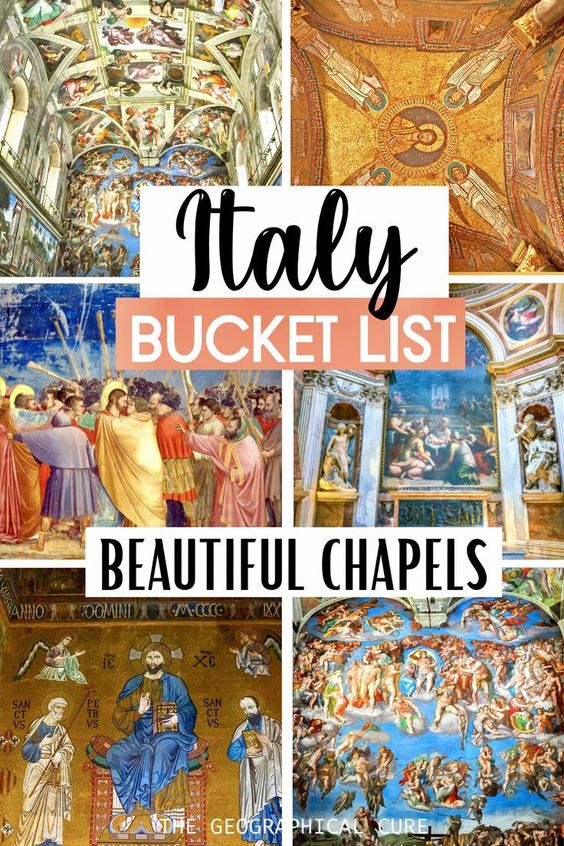Welcome to my guide on the 15 most beautiful and significant chapels to visit in Italy. If you’re an art and architecture enthusiast, Italy is the perfect destination for you.
Italy is a treasure trove of beautiful chapels, showcasing a plethora of styles from the Byzantine, Romanesque, Gothic, Renaissance, and Baroque periods.
Each chapel is a unique masterpiece that tells a story of the art and history of Italy. From grand and impressive structures to more intimate and serene spaces, each chapel is a testament to the skill and creativity of its creators.
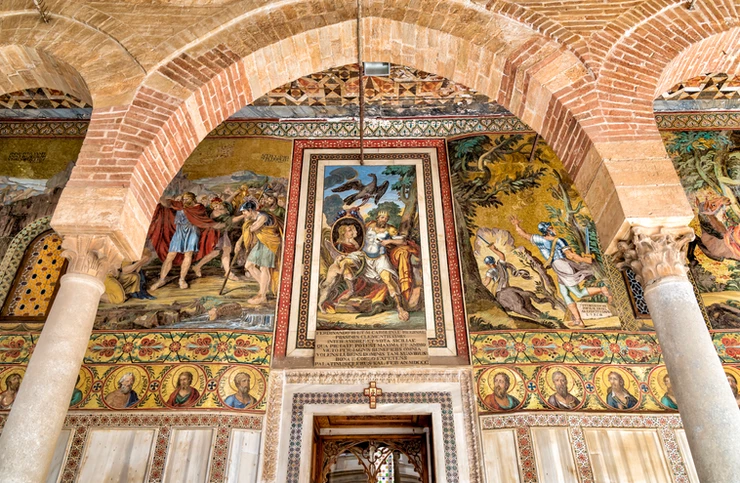
Whether you’re looking to explore the religious significance of these spaces or simply admire their artistic beauty, these 15 chapels are a must see on your trip to Italy.
What Is a Chapel?
But first, what exactly is a chapel? A chapel is a small intimate place for Christian worship. Chapels are usually a room or separate space within a church or other building, sometimes gated off. Some chapels are tiny. Others can be the size of a small church.
READ: Most Beautiful Churches in Italy
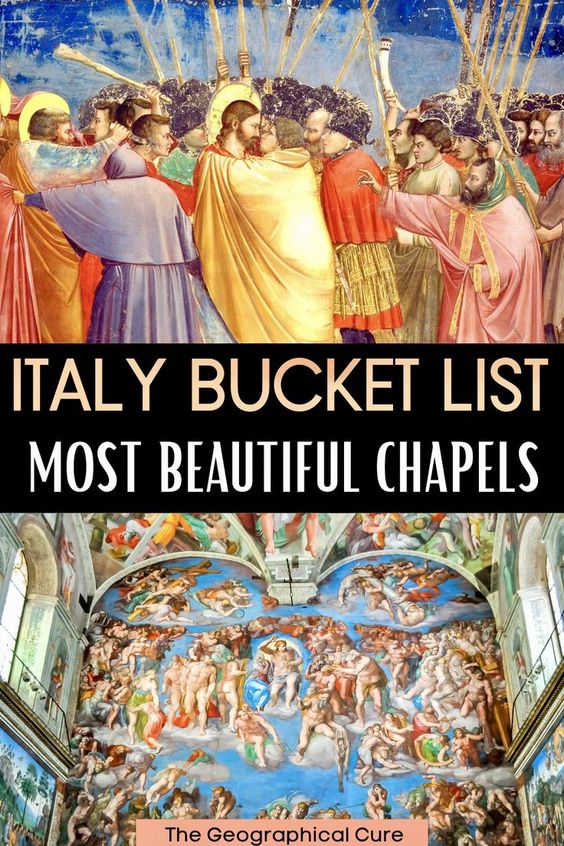
Chapels can be places that house relics, a place devoted to the cult of the Virgin Mary, or a place financed by a wealthy family or merchant guild exclusively for their use. The domestic family chapels often housed the family tombs.
With a church, chapels are usually arranged along the aisles of the nave. In Italy, they are decorated with some of the world’s most famous paintings, sculptures, and frescos.
There are a dizzying number of lovely chapels in Italy. It would be impossible to cover them all in a single blog post. These chapels are some of Italy’s most famous landmarks.
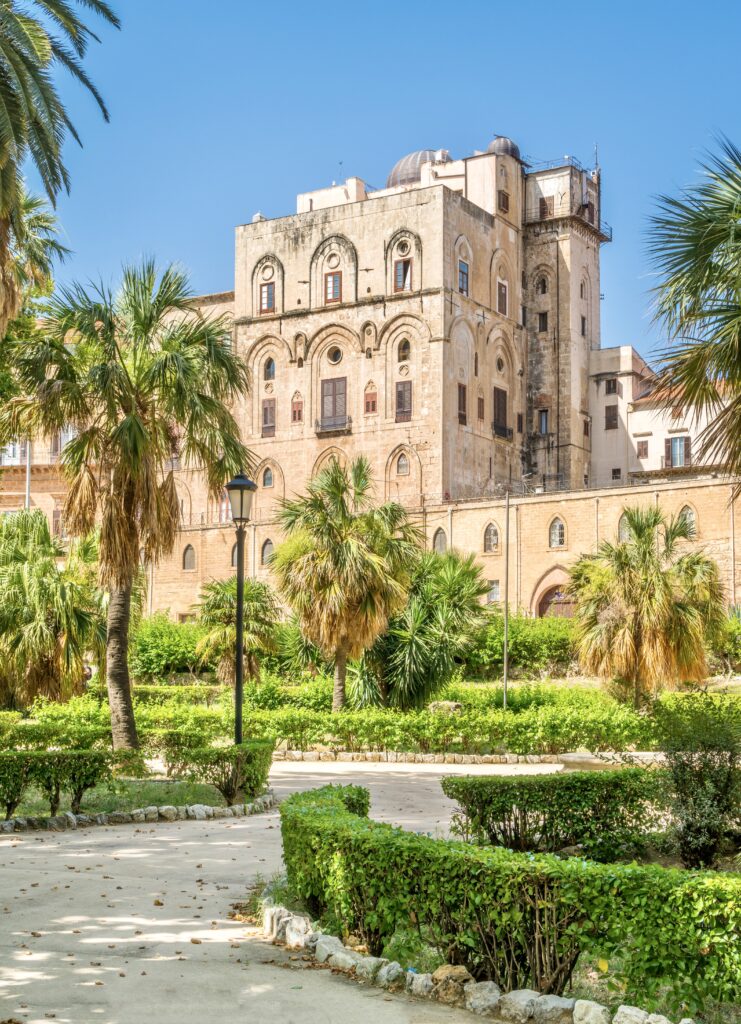
Guide To Italy’s Most Beautiful Chapels
So, let’s dive in and explore the most beautiful and significant chapels that Italy has to offer.
1. Palatine Chapel | Norman Palace, Palermo
The Palatine Chapel is certainly one of Italy’s most beautiful chapels. It’s located in the center of the Royal Palace (also known as the Norman Palace) in Palermo Sicily. It’s a UNESCO World Heritage Site, the gilded chapel of the Norman kings. Gold, mosaics, and marble cover every inch of the interior.
The Palatine Chapel was built in 1132 by the first king of Sicily, Roger II. It was his prestige project. The chapel became the religious center of the palace, a compound which today is the seat of the Sicilian Parliament.
The chapel is a three aisled Basilica plan hall. It has a diverse and elaborate collection of architectural and decorative elements of Byzantine, Arab, and Romanesque styles. It’s mix of religions and cultures that reflect the unique heritage of Sicily.
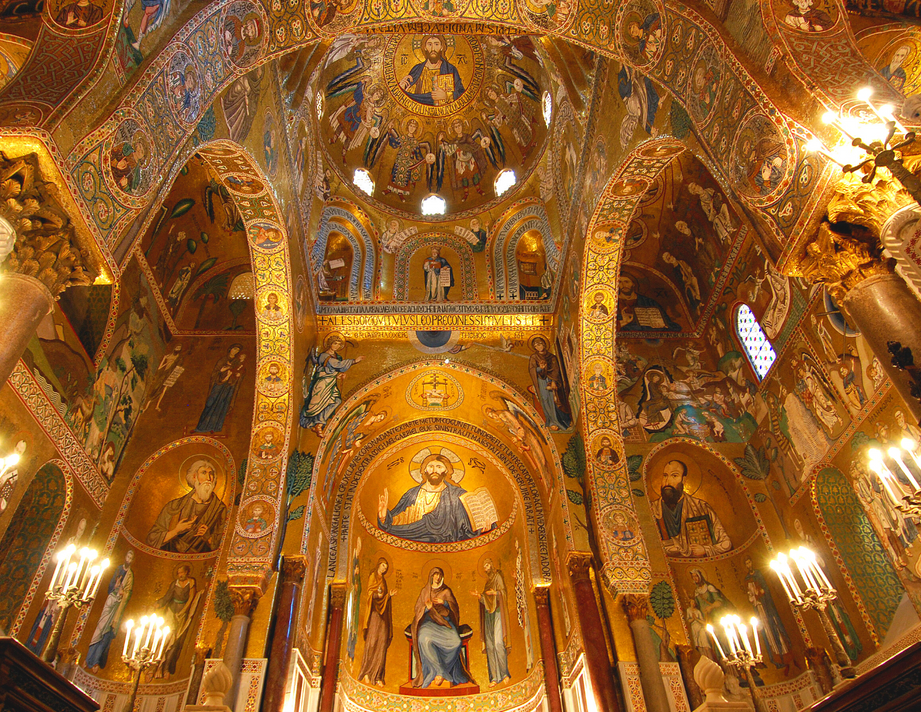
One of the chapel’s most distinctive features is the Islamic-style honeycomb ceiling, with three arches that form a cross. The coffers (recessed spaces) are in the shape of 8 pointed stars.
The ceiling is painted with Arab motifs and inscriptions. It’s an unlikely topper for a Christian church.
The chapel is decorated with golden Byzantine-style mosaics, that rival those in Ravenna and Venice. Christ, in the role of ruler of the universe, crowns the summit of the main dome. The usual prophets, saints, and angels are below him.
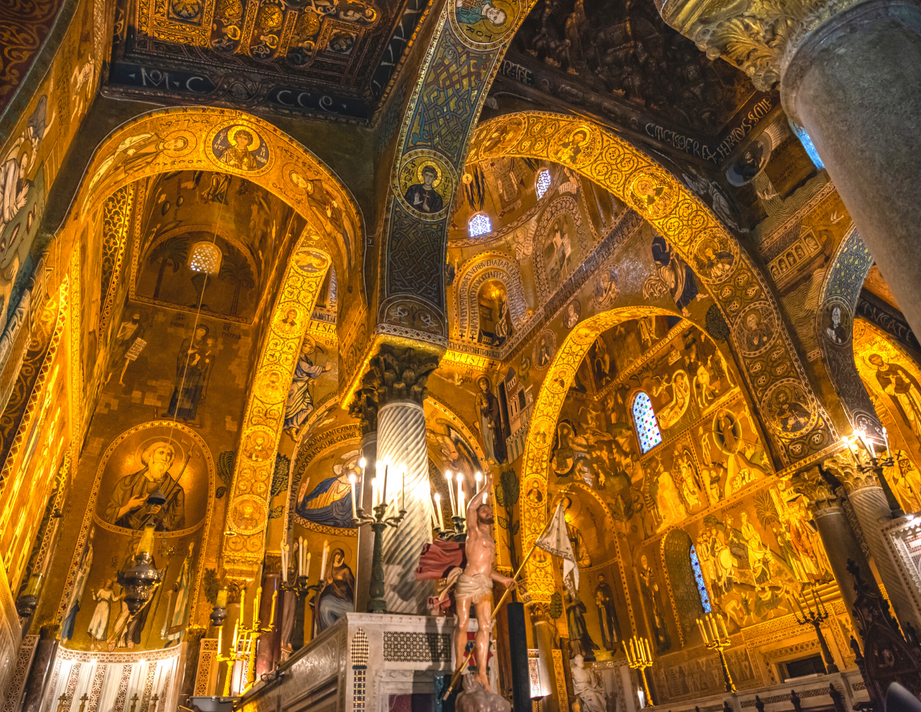
Scenes from the life of Christ are in the sanctuary. And Old Testament scenes, with the lives of Saint Peter and Saint Paul, adorn the side aisles.
For more information, here’s my complete guide to the Palatine Chapel. You may want to book a guided tour because there’s almost no signage and no audio guide.
READ: 2 Days In Palermo Itinerary
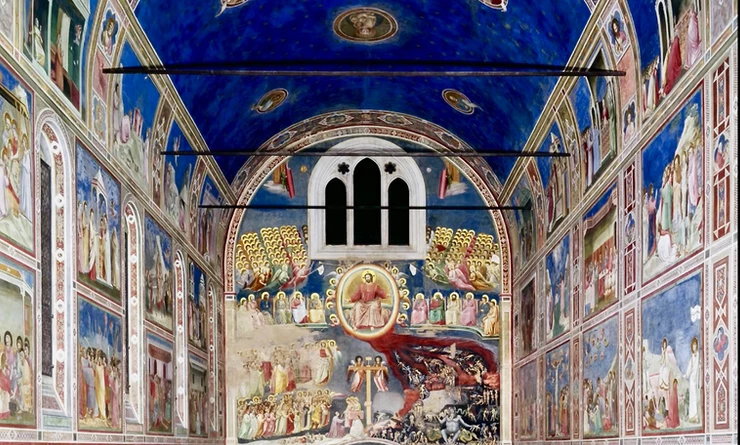
2. Scrovegni Chapel | Padua
The Scrovegni Chapel in Padua is wallpapered with exquisite frescos by Giotto, the greatest painter of the 14th century. The chapel is one of the world’s greatest art works. It was inscribed on the UNESCO list of world heritage sites in 2021.
Giotto painted a cycle of 39 frescos depicting the lives of Mary and Jesus in 1303-05. It’s a precious masterpiece of Italian art, as stunning in person as the Sistine Chapel in the Vatican Museums.
Giotto’s Scrovegni frescos were a watershed moment in art history. The chapel is considered one of the first examples of “modern art” and profoundly influenced subsequent Renaissance painters.
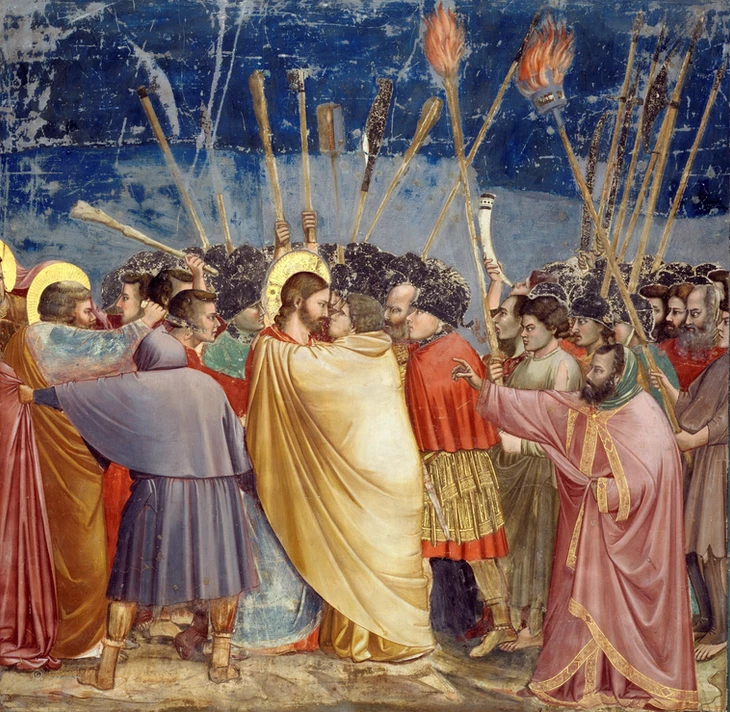
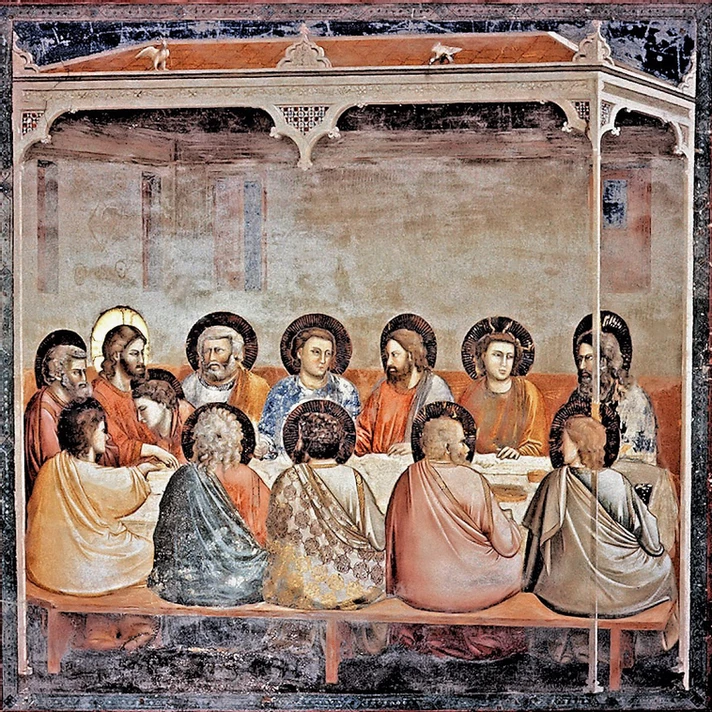
Almost like a comic book, Giotto’s frescos tell a continuous story in almost cinematic fashion. The narrative is clear and easy to read. This was important, as most people were illiterate in the 14th century.
The Annunciation is at one end of the nave, with The Last Judgment at the other end. The frescos are neatly arranged in three horizontal tiers, effectively divided into a trilogy: (1) the life of Mary (top register) (2), the life of Jesus (middle register), and (3) the Passion of Christ (top register). You read them clockwise top to bottom, in a sort of spiral.
In between the scenes are tromp l’oeil faux marble panels. They look like inlaid marble. But they’re paintings too. The ceiling is likewise painted, a star studded blue sky with images of Jesus and Mary.
Here’s my complete guide to the Scrovegni Chapel.
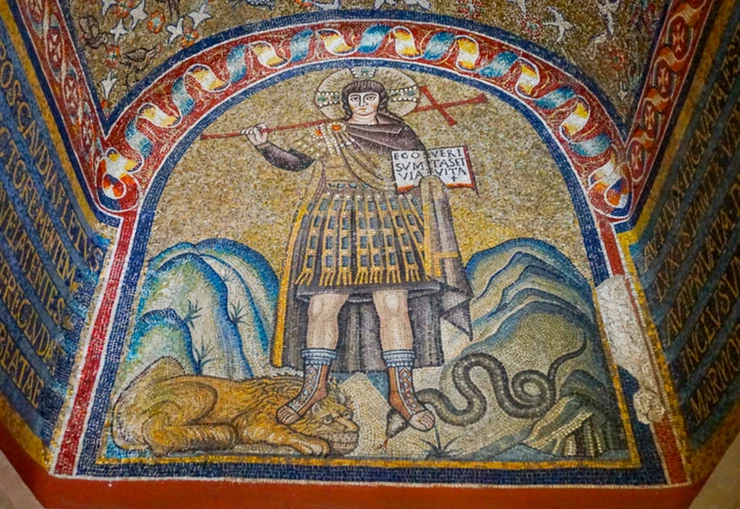
3. Chapel of Sant’Andrea, Ravenna
The Chapel of Saint’Andrea is inside Ravenna’s cathedral museum, the Museo Arcivescovile. It’s the only Bishop’s Chapel of the early Christian period that is preserved intact to the present day and is included in Ravenna’s UNESCO designation.
The decoration is characteristic of the magnificent Byzantine mosaics of Ravenna. At the time, the religion of Arianism dominated the region. Arianism departed from traditional Christian theology in that it posited that Christ was a created being.
The mosaics in this chapel are decidedly anti-Arianism. You’ll find a mosaic with an extremely rare depiction of Christ. He’s portrayed as a victorious warrior, his feet crushing a snake and lion. It was intended to affirm the Catholic orthodoxy that he was the son of God.
The chapel is quite tiny. But, if you’re in Ravenna, it’s worth going inside to see the Jesus mosaic, the golden starry sky, and the animal mosaics. There are over 99 species of birds depicted.
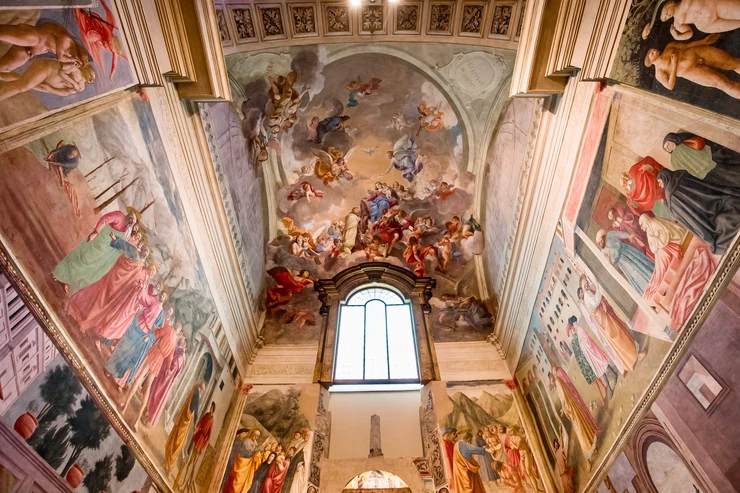
3. Brancacci Chapel, Church of Santa Maria del Carmine, Florence
The Brancacci Chapel is a supreme example of early Renaissance painting. It’s completely filled with frescos by Masaccio and his workshop. It’s considered one of the three important chapels of the Renaissance, along with the Giotto’s Scrovegni Chapel in Padua an Michelangelo’s Sistine Chapel in Rome.
Masaccio was an influential painter, despite dying mysteriously at just 27. He was one of the first painters in art history to experiment with single point perspective and three dimensional space.
A Medici enemy, Felice Brancacci, commissioned the fresco cycle in 1424. They were intended to represent the life of St. Peter, from original sin to the salvation of man. After Masaccio’s death, the frescos were completed by Fillipino Lippi.
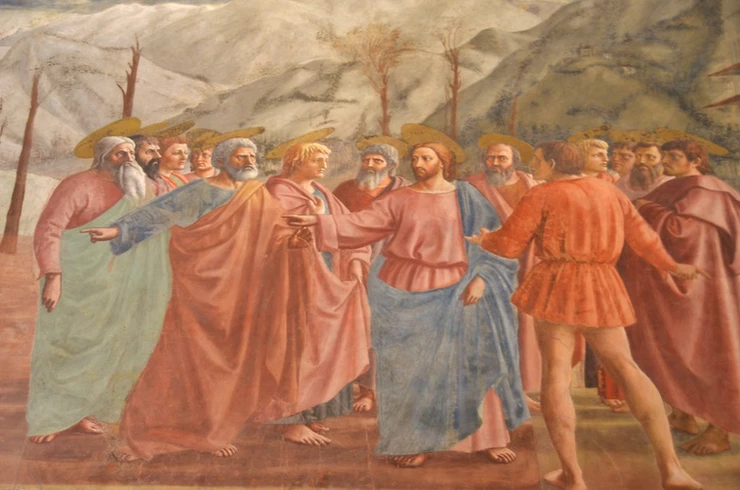
In the upper registry, there’s one of Masaccio’s greatest masterpieces, The Tribute Money. It’s a story from the New Testament when Christ is confronted by a tax collector. Christ performs a miracle, causing money to appear in the mouth of a fish.
Just to the left of The Tribute Money is another Masaccio must see masterpiece, the Expulsion of Adam and Eve From Eden. An armed angel banishes the pariahs. Adam appears ashamed and Eve cries. It’s an emotional painting.
Interestingly, Adam’s private parts were painted over with fig leafs on the order of the ultra religious Cosimo in 1642, similar to Michelangelo’s Last Judgment in the Vatican Museums. During restoration, the figure of Christ was returned to the original nude.
Here’s my complete guide to the Brancacci Chapel, with tips for visiting. Click here to book a ticket.
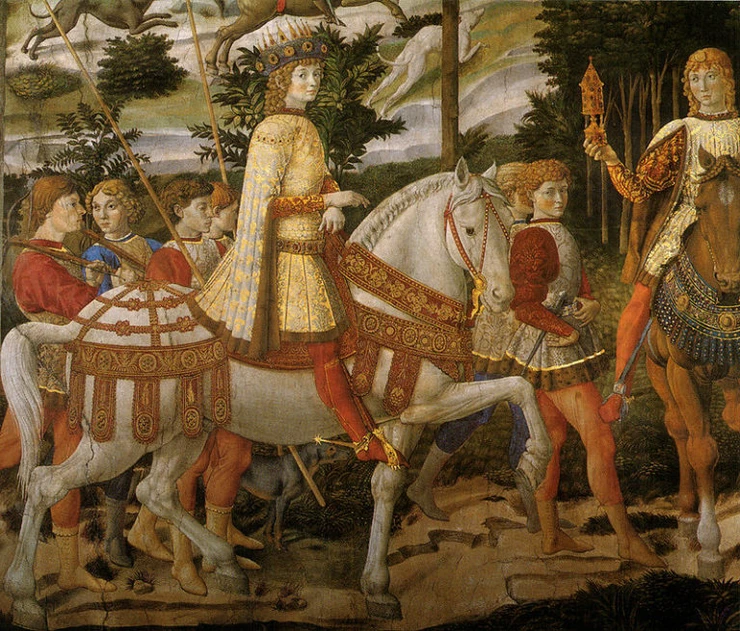
4. Chapel of the Magi | Medici-Riccardi Palace, Florence
The Chapel of the Magi is located in Florence’s Medici-Riccardi Palace. Though the palace itself is rather a brooding rusticated stone affair, upstairs in the Piano Nobile hides one of the most precious hidden gems in Florence — the Chapel of the Magi. The chapel is accessed via a stairway from the courtyard.
The Chapel of the Magi was a private chapel used exclusively for the Medici’s prayer and devotion. The chapel is decorated with a beautiful series of frescos painted in 1459 by Benozzo Gozzoli. Gozzoli was trained by Ghiberti and Fra Angelico, and thus developed a charming narrative style.
The frescos are in two parts, the Procession of the Magi on three walls in the main room and the Adoration of the Magi in the chancel.
The frescos are meant to glorify the Medici family. It was a form of propaganda to show their wealth and greatness. Throughout the chapel, there’s an abundance of purple porphyry and gold, just to underscore the point.
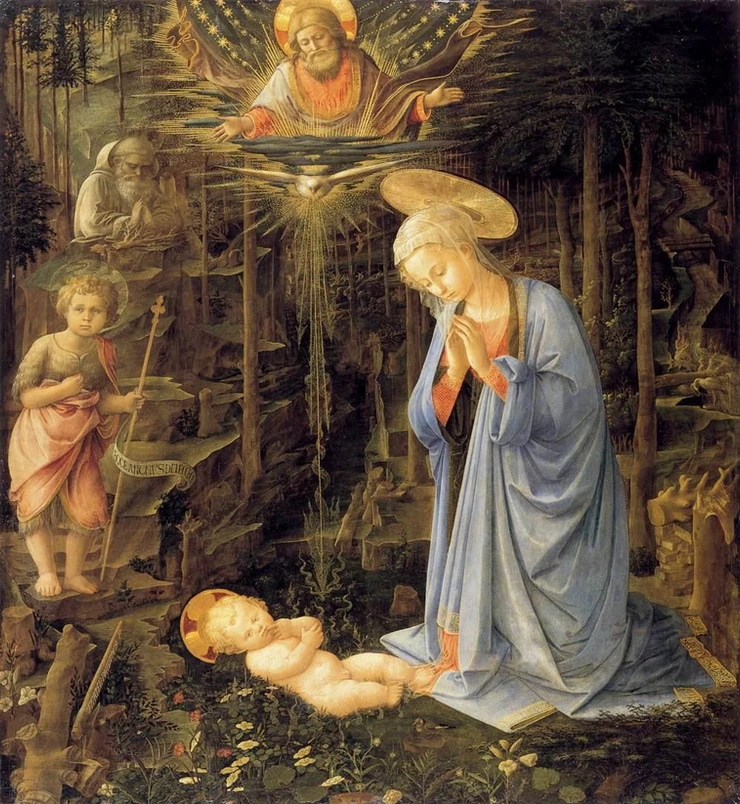
The Procession of the Magi covers three of the four chapel walls. Each wall represents one of the three kings or magi arriving in Bethlehem to pay homage to the newborn king, bringing expensive gifts.
Famous Medici appear in under the guise of the magi, equating themselves with immortality.
On the east wall, there’s a portrait of Lorenzo the Magnificent at the age of 10 on a white horse. There’s also a portrait of Giuliano, Lorenzo’s brother who was assassinated in the Pazzi Conspiracy.
Cosimo the Elder appears riding a donkey, a reference to Jesus himself. Is Cosimo trying to appear modest or as the second coming? It’s delightfully unclear.
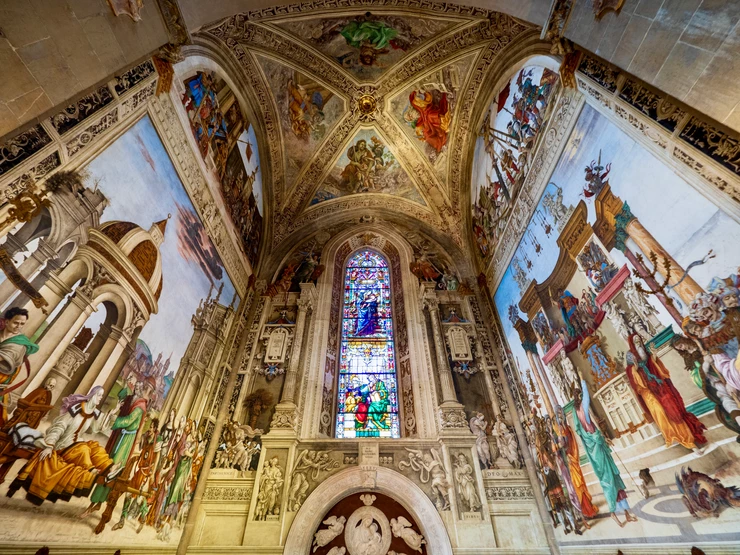
5. Fillipo Strozzi Chapel | Basilica of Santa Maria Novella, Florence
The powerful Medici dynasty banished the Strozzi family from Florence twice, in 1434 and again in 1458. The Strozzi returned in 1466. To help restore their tarnished reputation, the Strozzi engaged in some showy building projects.
READ: History of the Medici Dynasty
The Filippo Strozzi Chapel is one of the major chapels in Santa Maria Novella, just to the right of the main altar. The chapel contains precious frescos by Filippino Lippi, an early Renaissance luminary.
He painted them between late 1480s and 1502. Their completion was delayed because Lippi was called to Rome to work on the Carafa Chapel in Santa Maria Sopra Minerva.
The frescos depict the life of the apostles Philip and James. The bronze crucifix on the main altar is by the sculptor Giambologna. The stained glass windows were created in 1492 by Alessandro Agolanti, based on cartoons by Ghirlandaio.
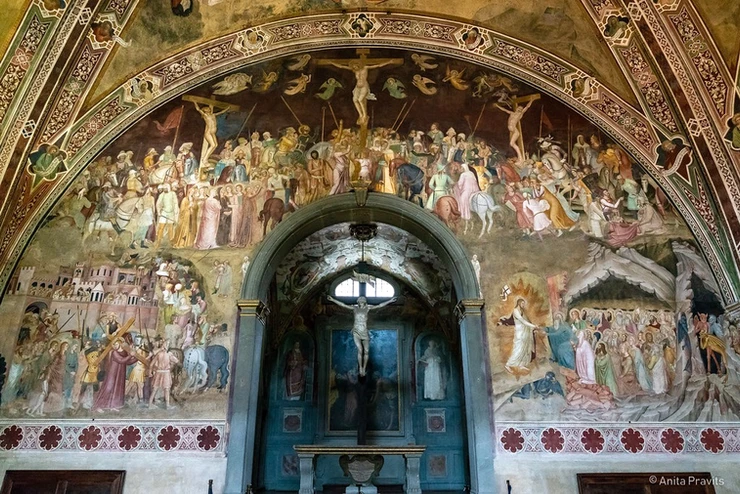
6. The Spanish Chapel | Basilica of Santa Maria Novella, Florence
Another highlight of Santa Maria Novella is the Chapter House, erected circa 1350. It’s also called the Spanish Chapel.
The chapel is located in the Green Cloister and is one of the most underrated hidden gems in Florence. A Chapter House was the “boardroom” for the monks where they discussed internal affairs or had collective confessions.
This Chapter House was also the scene for the trial of 14th century celebrity, St. Catherine of Siena. She was a famous adherent of St. Francis of Assisi. She’s credited with helping to return the papacy to Rome from Avignon.
Because St. Catherine purported to have divine visions and work on God’s behest, she was accused of heresy. But she was absolved at trial. She’s depicted in one of the frescos in her Franciscan habit.
The Spanish Chapel was commissioned by Mico (Buonamico) Guadalotti. He was a wealthy patron living near the church. In his will, he left money for the construction and decoration of the Spanish Chapel.
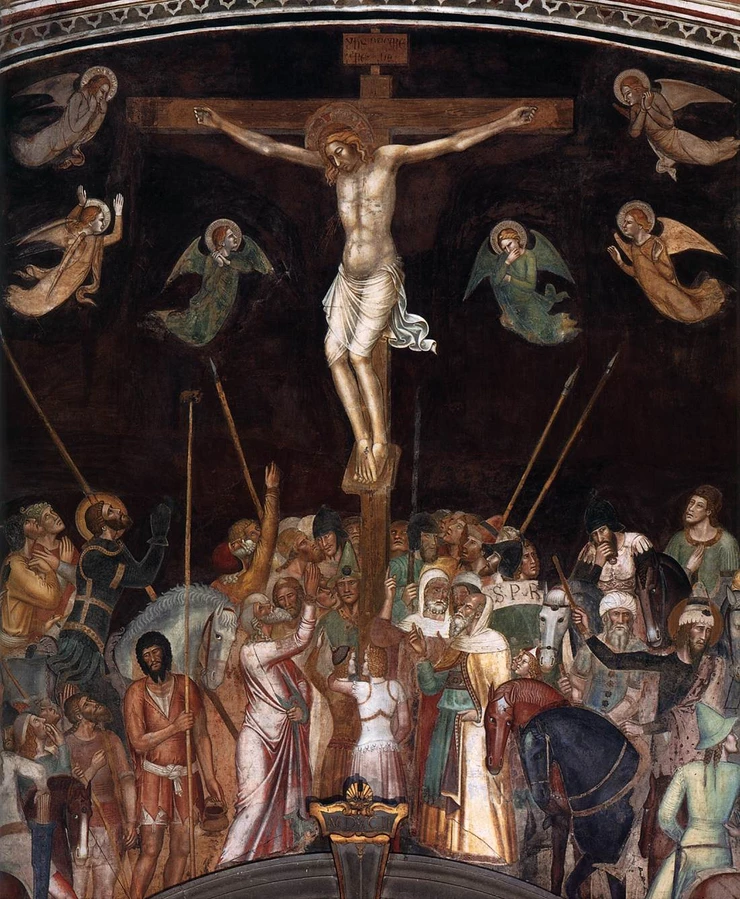
The stunning chapel was painted by Andrea di Bonaiuto in 1365-68. Bonaiuto was so famous that he was known as Andrea da Firenze.
Some scholars think the Spanish Chapel is emblematic of the post Black death style of painting. That style had a pessimistic and dark POV and often depicted violence. Bonaiuto’s frescos are threatening, but they at least have a bright jewel color scheme and are beautifully rendered.
The frescos are a sort of Dominican propaganda vehicle, packed with religious information and teachings. They show the life, death, passion, and resurrection of Christ. The cycle celebrates the spiritual and intellectual achievements of the Dominican order.
The overall theme is salvation through Christ, with the aid and knowledge of the Dominicans. Black and white clad Dominican preach and lead mankind away from evil and up toward St. Peter and the pearly gates of heaven.
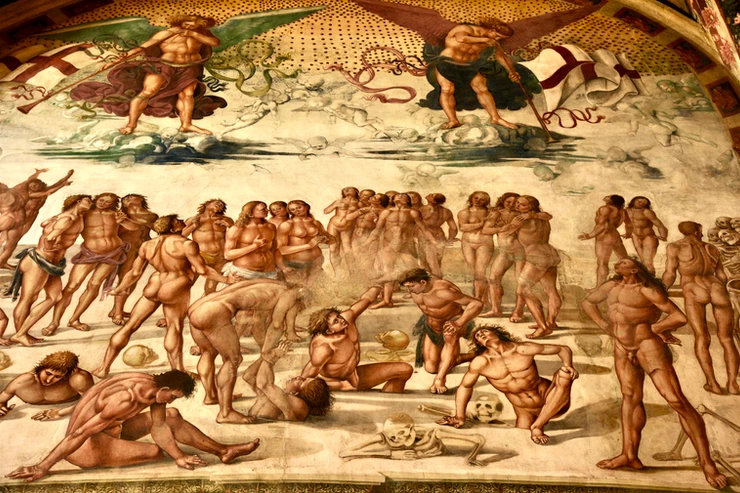
7. Chapel of San Brizio | Orvieto Cathedral, Orvieto
Orvieto is home to one of the most beautiful churches in Italy, Orvieto Cathedral. Inside is the stunning Chapel of San Brizio, built between 1408-44. In 1622, the chapel was dedicated to San Brizio, one of the first bishops to evangelize the town of Orvieto.
This chapel boasts one of the Renaissance’s greatest fresco cycles. The frescos were begun in 1447 by Fra Angelico and Benozzo Gozzoli. But it was mostly completed by the great Luca Signorelli, who also has a fresco in the Sistine Chapel.
Signorelli finished decorating the vault in 1499. Then, he was commissioned to paint the lunettes.
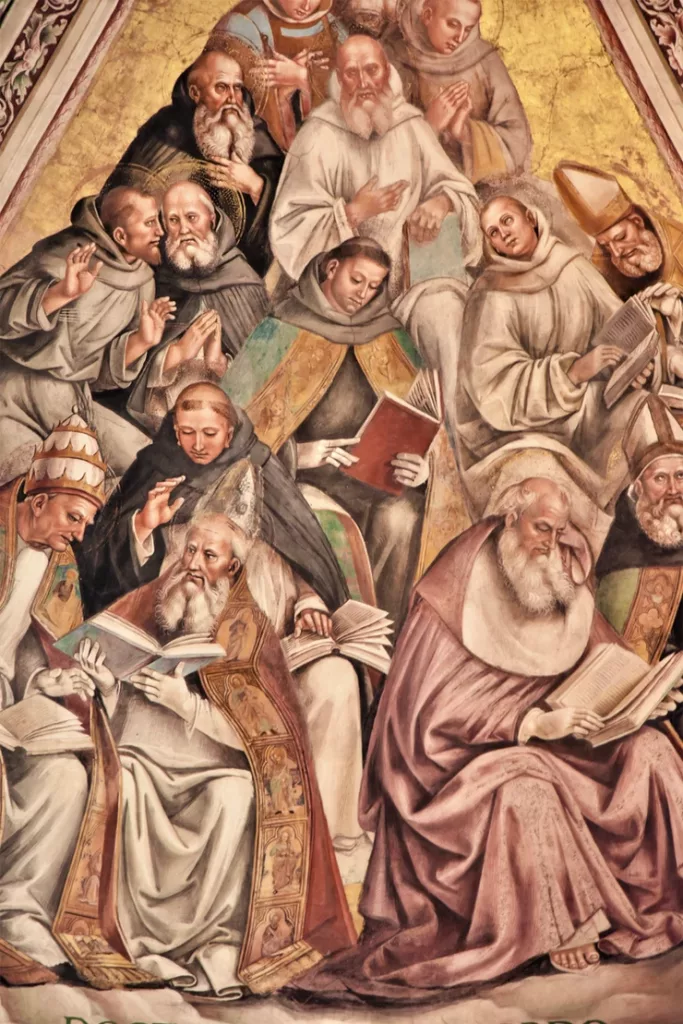
His San Brizio frescos are considered his masterpiece, his greatest and most complex work. They’re one of the most ambitious and inventive depictions of the apocalypse and last judgment in Italian Renaissance art.
Signorelli’s frescos depict the usual religious themes — temptation, damnation, apocalypse, and salvation. Signorelli shows off his ability to draw the human body.
The Sermon and Deeds of the Antichrist is considered the best painting, his magnus opus, full of fantastical imagery. In it, a false prophet is shown disseminating his lies. This was likely a reference to the mad monk of Florence, Savonarola, who was burned at the stake for heresy. It’s one of the only paintings of an antichrist in existence.
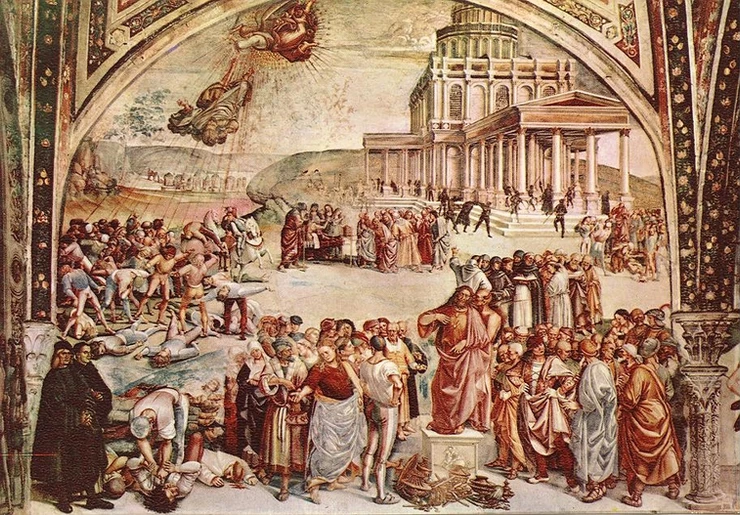
Behind the antichrist, Satan whispers in his ear. All around them are scenes of depravity. But, in the end, the angel Michael smites the purveyor or lies with the sword of divine justice.
The Damned Cast Into Hell features writhing masses of human bodies, who are tortured by demons. The End of the World, painted over the arch of the entrance, is especially terrifying. It’s a searing vision of the end of the world, executed with fiendish exuberance.
According to art historian Giorgio Vasari, Michelangelo came to inspect the chapel before beginning his own master work, The Last Judgment in the Sistine Chapel.
Here’s my complete guide to visiting Orvieto Cathedral. Click here to pre-book a ticket.
I also highly recommend this guided tour of Orvieto. The guide even used a laser pointer to highlights elements of the frescos for me.
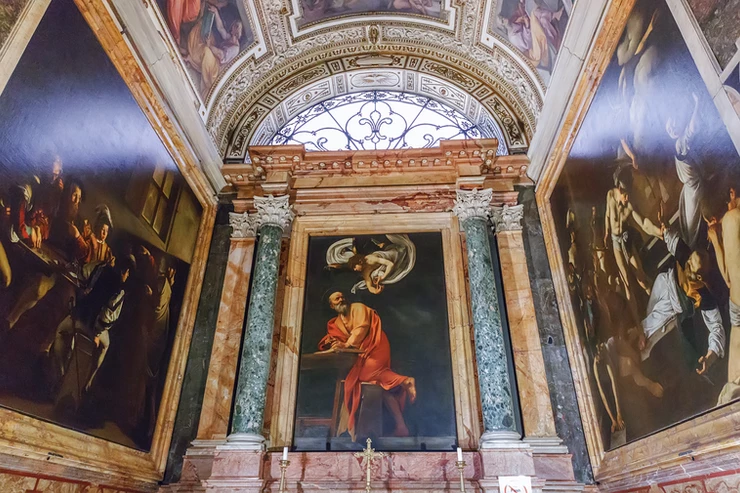
8. Contarelli Chapel | St. Louis of the French, Rome
The small church of San Luigi dei Francesi, or St. Louis of the French, is one of the best places in the world to see the paintings of Caravaggio. Inside is the spectacular Contarelli Chapel. It houses an in situ Caravaggio triptych about the life of St. Mathew. (In situ just means the art is shown in the host site for which it was created.)
The three paintings, which are all massive, are:
- The Calling of St. Matthew (1599-1600)
- The Martyrdom of St. Matthew (1600-1601)
- St. Matthew and the Angel (1602)
You can see the paintings up close and personal under perfect lighting conditions. In each one, a seemingly regular person is caught in a dramatic moment.
The Calling is my personal favorite of the triad. The painting looks almost like a tavern scene. The hand of Christ extends toward St. Matthew, who’s depicted in his previous profession as a tax collector. Peering out of the gloom on the far right is a self portrait of Caravaggio.
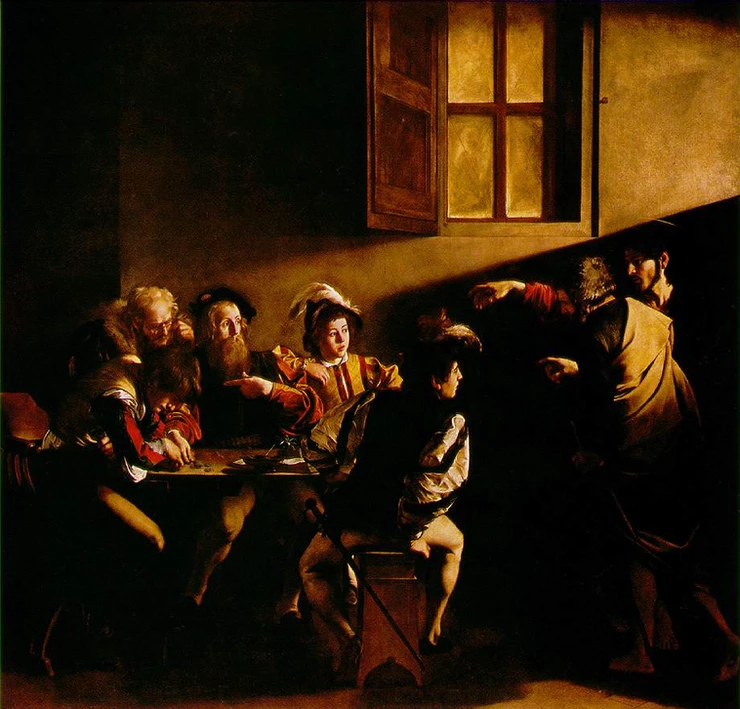
The extended hand has been compared to the hand in Michelangelo’s Creation of Adam on the ceiling of the Sistine Chapel in the Vatican. It perhaps reflects a self confident Caravaggio.
In Martyrdom, Caravaggio shows the murder of Saint Matthew. An angel extends his arm to Matthew to bring the saint into heaven. At the back of the painting, Caravaggio (once again) paints a self portrait of himself looking in on the scene.
In St. Matthew and the Angel, also called The Inspiration of St. Matthew, the saint is shown at his desk writing gospels. He appears as a dignified scholar saint.
The first version of the painting depicted Matthew as a poor peasant with dirty feet and crossed legs. It was rejected outright and Caravaggio had to create another version. The original ended up in a gallery in Berlin. But it was destroyed in WWII.
READ: Guide To the Caravaggio Trail in Rome
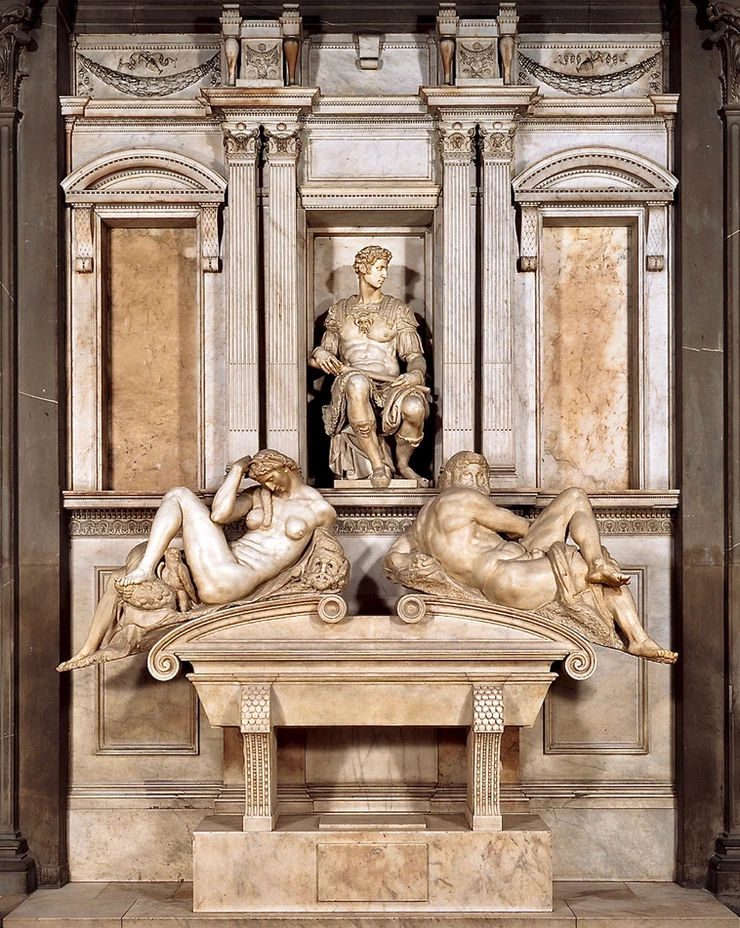
9. Medici Chapels | Basilica of San Lorenzo, Florence
The Medici Chapels are located inside the Basilica of San Lorenzo in Florence. There are two chapels — the the Chapel of the Princes and Michelangelo’s New Sacristy. I’ll discuss Michelangelo’s chapel
In June, Giulio de’ Medici commissioned Michelangelo to build burial chapels for the Medici family. Originally, there were meant to be four monumental Medici tombs. However, Michelangelo only finished two for Giuliano and Lorenzo, who were relatively less important members of the Medici family.
The chapel is a unique masterpiece as it was both designed and decorated by a single artist. Michelangelo even intended to paint frescos in the chapel, but unfortunately, they were never started.
The coffered dome of the chapel resembles Rome’s Pantheon, while the walls are adorned with beautiful pink, green, gold, and white marble.
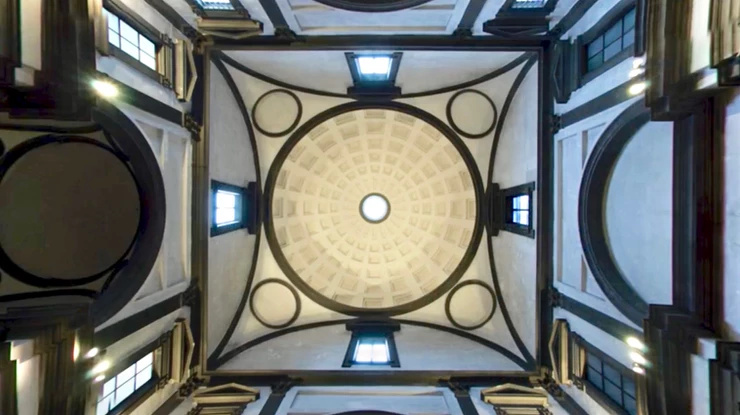
There are 6 tomb sculptures carved by Michelangelo. Four are allegories of the passage of time. They were intended to convey the message that time destroys everything earthly, that the days of our lives ineluctably lead to our death.
On the tomb of Lorenzo, the effigy of Lorenzo is shown at the top as a brooding introvert, whose face remains in shadow. Below him are the sculptures of Dawn and Dusk. Dawn suggests the emergence of light. Dusk suggests twilight.
On the tomb of Giuliano, Giuliano’s effigy shows him as an extrovert. This is a beautiful sculpture. It’s one of Michelangelo’s most idealized pieces. I mean, just look at the long elegant neck. The two tomb statues below are allegories of Night and Day.
Night is regarded as one of Michelangelo’s finest works. The sculpture was based on a classical drawing of Leda. There’s no doubt who she is because of the owl and bag of poppies. She’s also the only sleeping sculpture.
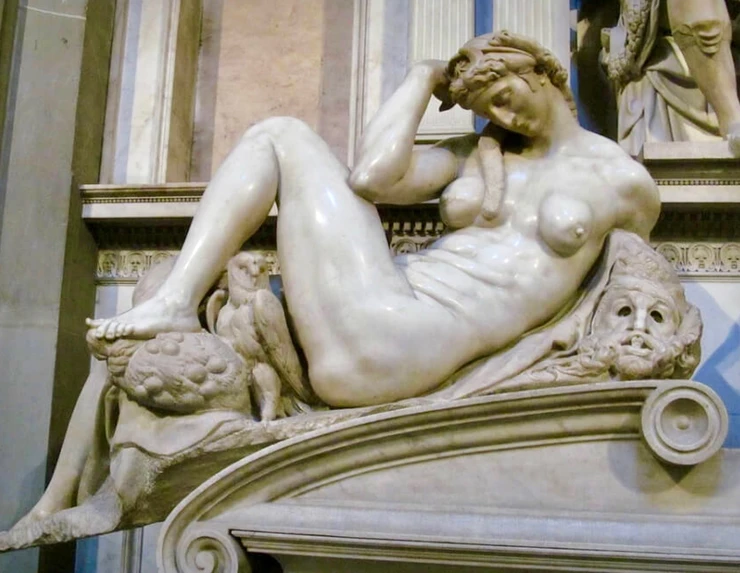
In 1527, Michelangelo returned to Florence to defend republican forces during a civil war. When Florence fell, Michelangelo retreated into a secret room below the Medici Chapels until he received was pardoned by the Medici pope Clement VII.
But the cost of the pardon? Michelangelo had to paint The Last Judgment in the Sistine Chapel.
In 1975, a great discovery was made. Michelangelo’s secret room was found when a museum director spotted a trap door. The room contained 180 charcoal sketches and doodles on the walls. 97 are attributed to Michelangelo, identified because they replicated his known works.
Here’s my complete guide to visiting the Medici Chapels. Click here to purchase a ticket with a time slot.
You can also book a guided tour of the chapels. This isn’t a bad idea because there’s not much explanatory signage.
READ: The Michelangelo Guide To Florence
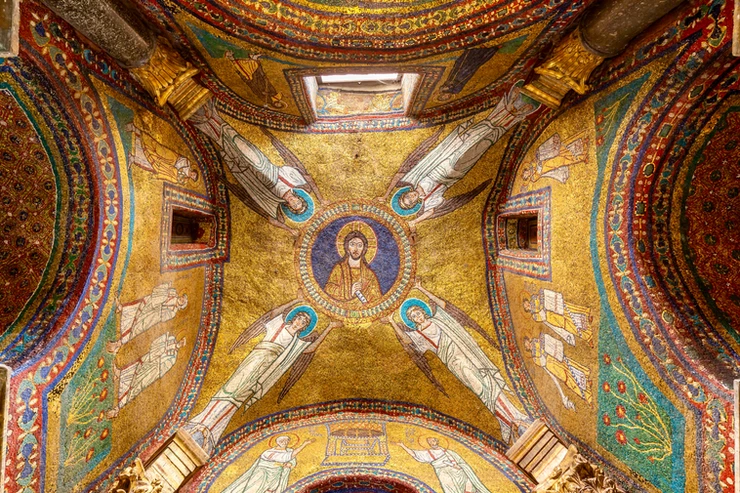
10. Chapel of Saint Xeno | Santa Prassede, Rome
Santa Prassede is an ancient basilica and an important example of Byzantine art in Rome. The beautiful Chapel of Saint Xeno is from the 9th century. It’s covered top to bottom with glittering mosaics. In the Middle Ages, it was called the “Garden of Paradise.”
Jesus is in the center of the ceiling, held up by four angels called “Paschal’s Lolitas.” Each angel stands on an ancient Roman column.
The side entrance has a famous row of four women, who seem like a mixture of Roman matron and Byzantine princess. The wall outside the chapel has a mosaic of Jesus, Mary, and the saints, faces set within circles.
The apse and triumphal arch are also decorated with mosaics. The arch depicts the Heavenly New Jerusalem.
The apse mosaic shows Jesus standing on a hill with an array of saints and Pope Paschal. God’s hand reaches down to touch his crown. Below them are the usual line of lambs on a gold background.
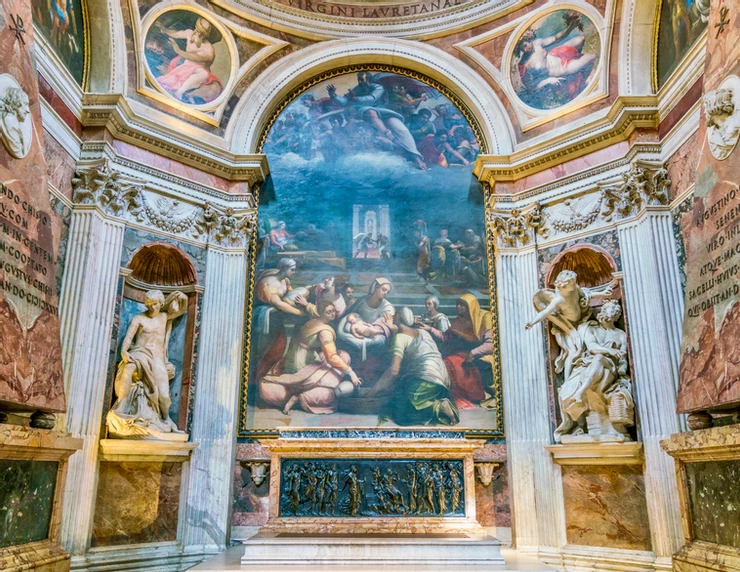
11. Chigi Chapel | Santa Maria del Popolo, Rome
The Chigi Chapel in Santa Maria del Popolo is an impressive and spectacularly underrated site in Rome. It was originally designed by Raphael, who was commissioned by Agostino Chigi of Villa Farnesina fame. Bernini finished the chapel 150 years later for another Chigi, Pope Alexander VII.
The chapel not only features sculptures by Bernini, but has paintings by Caravaggio and mosaics designed by Raphael. The floor mosaic is Bernini’s Winged Death with the Chigi coat of arms.
READ: Guide To the Bernini Trail in Rome
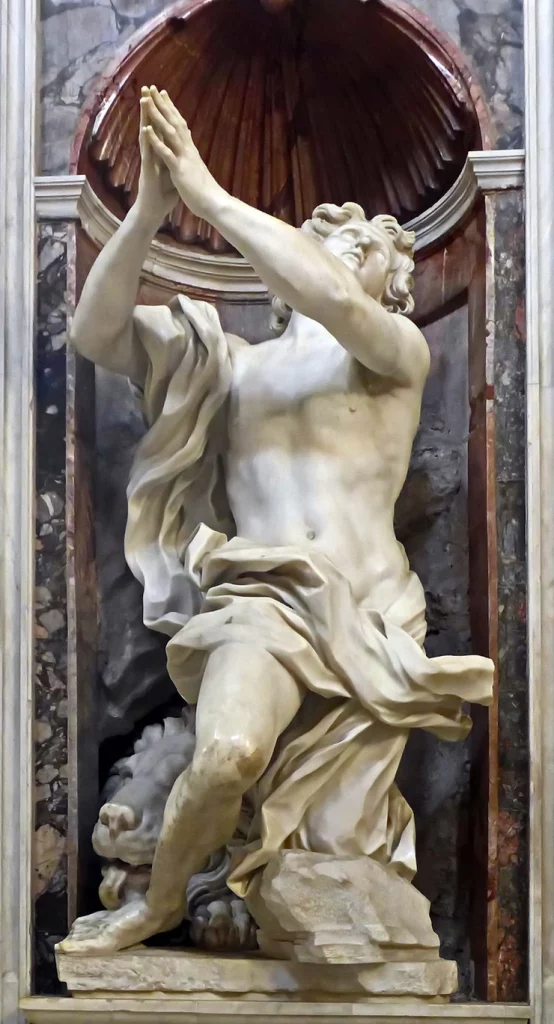
At first glance, the Chigi Chapel seems just like any other church chapel, adorned with art and inlaid with precious stone. But the space has a compelling geometry.
There’s an interplay of drum and dome, a rhythm created by the vertical Corinthian pilasters, and matching red marble pyramids mark the Chigis’ graves.
For this chapel, Bernini carved two sculptural groups in 1655-61, Daniel in the Lions’ Den and Habakkuk and the Angel.
These two sculptures show the beginning of Bernini’s late style, with slightly more elongated figures characteristic of the early Mannerism.
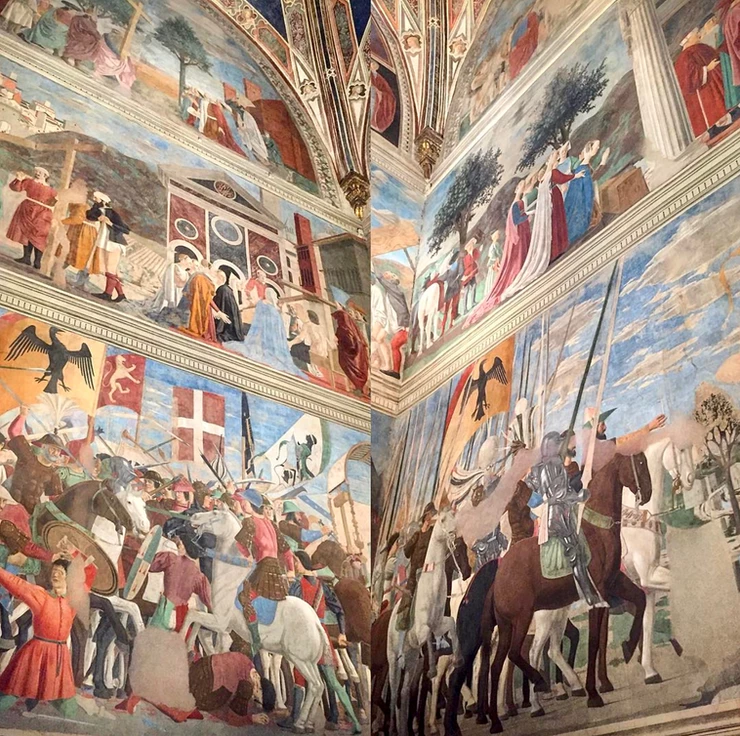
12. Capella Maggiore | Church of San Francesco, Arezzo
This stunning chapel contains Piero della Francesca’s greatest masterpiece, the Legend of the True Cross. Piero della Francesca was a hugely influential artist.
Most art historians consider it one of the greatest fresco cycles ever, certainly of the early Renaissance. Piero’s works and early use of perspective (showing Masaccio’s influence) left a profound influence on the Renaissance.
Commissioned by the wealthy Bacci family, the fresco (and legend) trace the history of Christ’s cross. The overall theme is the triumph of the cross, which guides man to salvation.
READ: Guide To the Piero della Francesca Trail
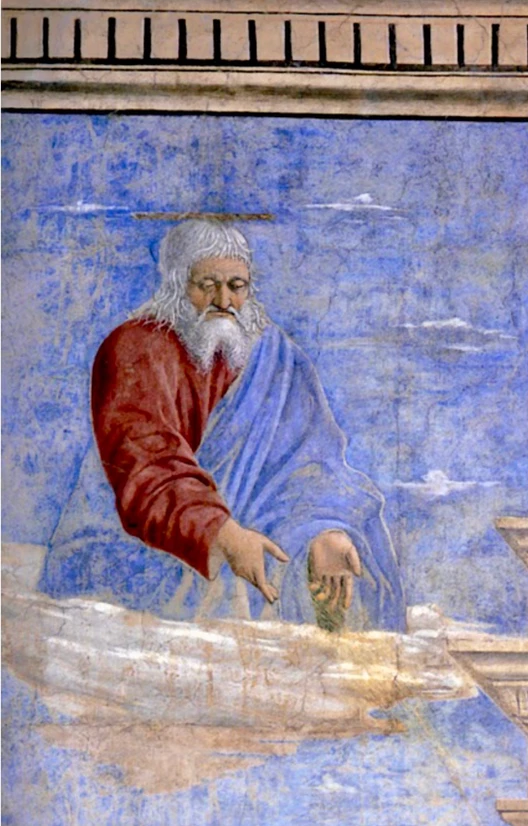
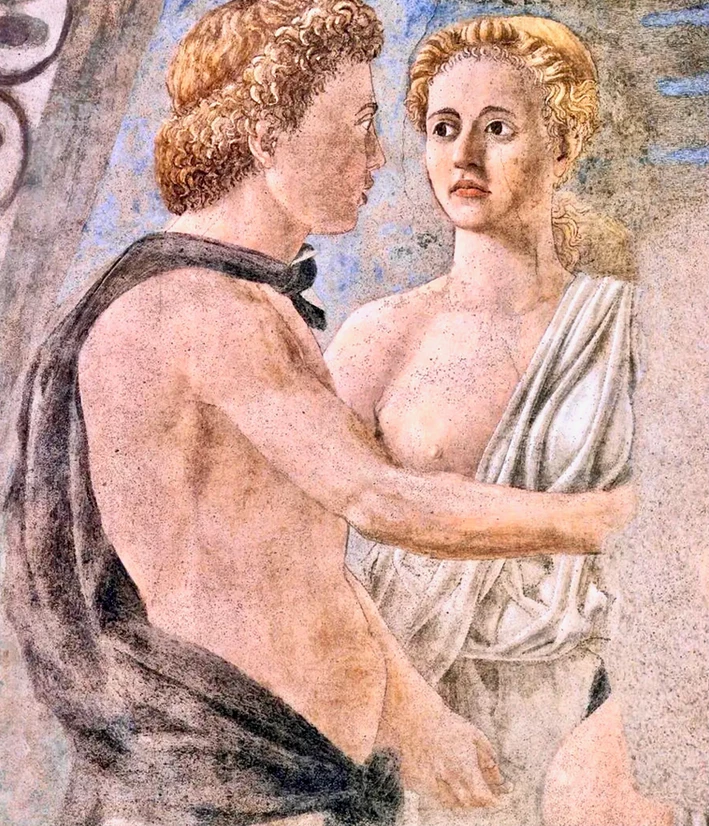
The highly complex fresco is quietly majestic, each scene rendered with solemnity. The fresco captures all the special traits of Piero’s art — spatial structure with prefect perspective, subtle and diffused light, color contrast between warm and cold tones to create the illusion of space.
The images are so potent and pure that they ravish hearts. Giorgio Vasari claimed that the frescos were “so well-executed that but for the gift of speech they seemed alive.”
Close up, the emotive figures assume personalties. They smile, observe, exalt, grieve, and die expressive deaths. As was the common practice at the time, Piero include discrete portraits of his patrons in the narrative.
Click here for my complete guide to the The Legend of the True Cross. You may also be interested in my one day in Arezzo itinerary.
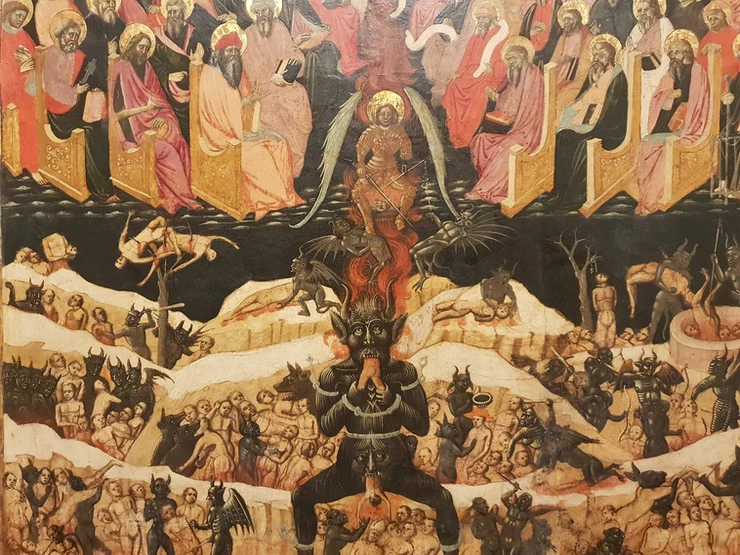
13. Cappella Bolognini | Basilica of San Petronio, Bologna
This chapel, also called the Chapel of the Magi, is one of the 22 chapels in the Basilica of San Petronio in Bologna. It was built around 1400. The chapel has beautiful stained glass windows, with 12 saints enthroned.
The chapel also has walls decorated with one of the most original depictions of Heaven and Hell. It was painted between 1408-20 by Giovanni da Modena. The frescos were inspired by Dante’s Divine Comedy. Modena depicts paradise, an inferno, and the journey of the magi.
Modena was directed to paint the Inferno “as horrible as possible.” It was intended to inspire feelings of terror. Its dominated by the massive figure of Lucifer, who eats sinners. The facial expressions are dramatically accentuated.
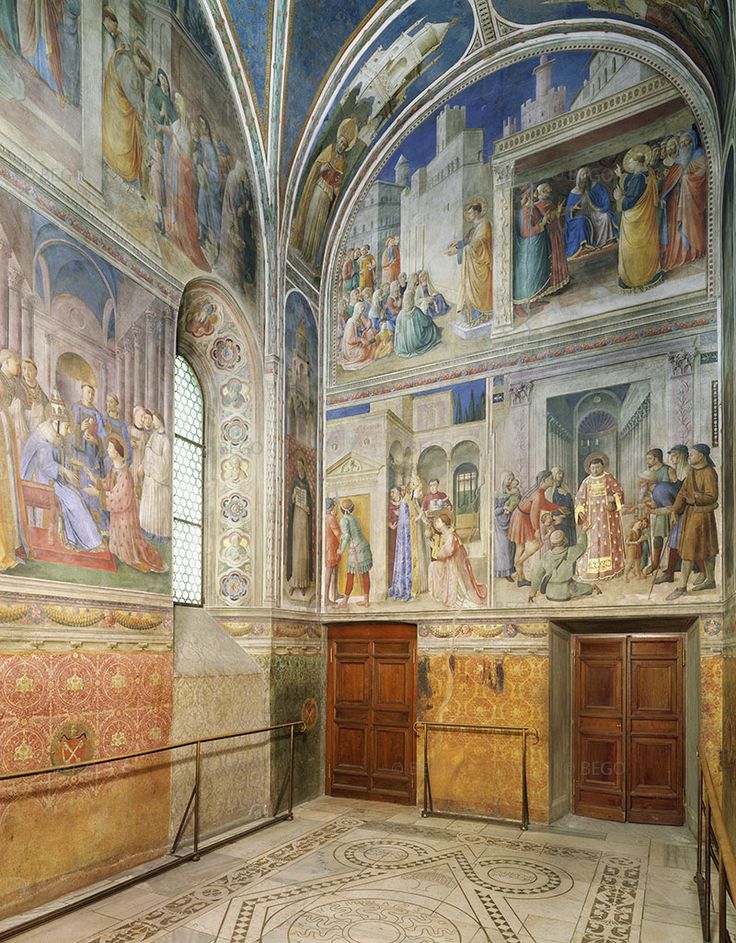
14. Niccoline Chapel, Vatican Museums, Vatican City
The Niccoline Chapel is one of the most beautiful rooms in the Vatican, a little jewel box. It once hosted the pope’s conclave, or election, before the Sistine Chapel.
The chapel houses vibrant 15th century Early Renaissance frescoes. They were painted by Fra Angelico and his pupil Benozzo Gozzoli in 1448-49.
Fra Angelico was the most important painter of the Early Renaissance. He was a monk who combined a life of devotion to god and painting. His art works are known for their harmonious and classic beauty.
The two artists turned the chapel’s vault into a starry sky with four evangelists in the center. The walls are painted with scenes from the lives of Saint Stephen and Saint Lawrence.
The most famous scene is Fra Angelico’s Preaching of St. Stephen and St. Stephen Addressing the Council. It’s considered a masterpiece of a mature Fra Angelico. It has the artist’s classic well-balanced composition and harmonious colors.
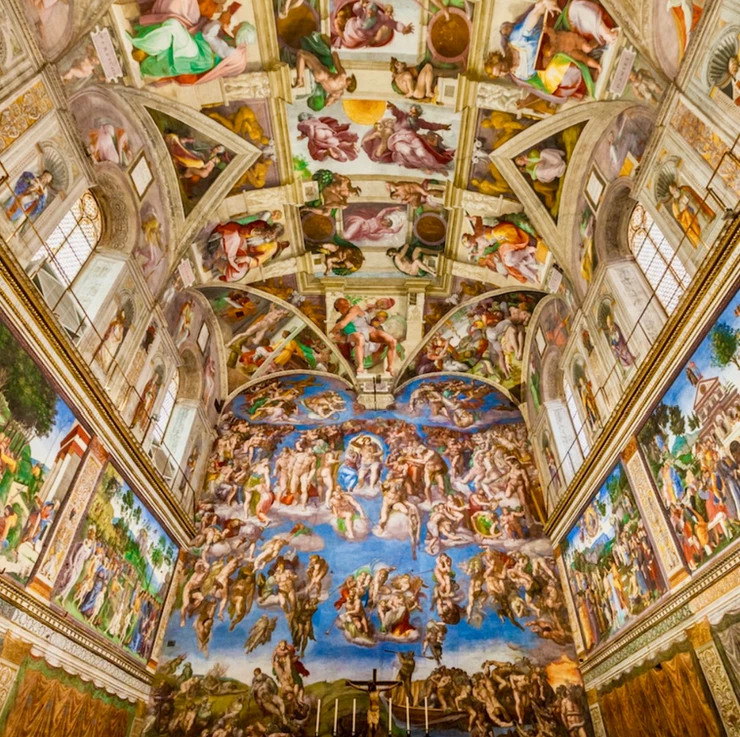
15. Sistine Chapel, Vatican Museums, Vatican City
I end with the world’s most famous chapel, the Sistine Chapel. It’s perhaps the world’s most famous interior decorated space. And it (mostly) came out of the mind of just one man, Michelangelo, nicknamed Il Divino. The scale of the work and breadth of Michelangelo’s imagination is incredible.
20,000 people visit daily to cast their eyes upward to the glorious ceiling. Originally, the ceiling of the Sistine Chapel was azure blue with stars. In 1508, Pope Julius II summoned Michelangelo from Florence to paint the ceiling of his private chapel.
After four and a half years of physical strain and conflict with the Pope, Michelangelo had painted nearly 9,000 square feet of ceiling with some of the most beautiful and sublime figures in history.
The frescos depict scenes exclusively from the Old Testament. They seem to open up the chapel to heaven. There’s a lot of overly perfect naked male bodies, Michelangelo’s particular obsession. He considered muscled masculinity a sign of the divine.
Michelangelo painted the frescos standing up, not laying down as legend and The Agony and the Ecstasy holds. You’ll have to crane your neck to see the frescos, just like Michelangelo.
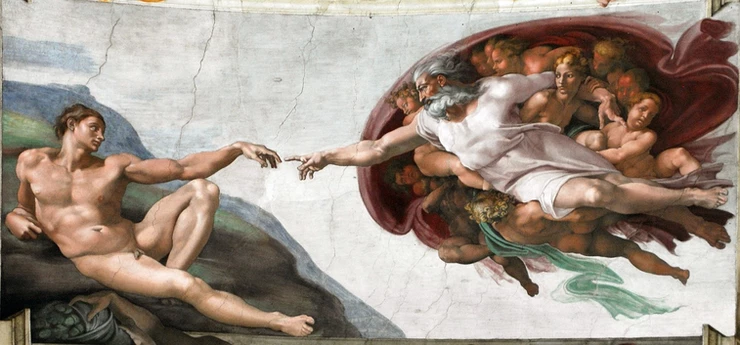
When the frescos were completed, they won universal praise. Generations of artists would study and be inspired by Michelangelo’s works. One of the first was a young Raphael, who was working on the nearby Raphael Rooms during Michelangelo’s project.
In 1536, 24 years after he had finished painting the ceiling, Michelangelo returned to the Sistine Chapel. At age 61, Pope Clement VII summoned him to paint The Last Judgment on the altar wall. Clement died soon after the commission, but his successor Pope Paul III carried out the project.
This time around, Michelangelo worked entirely alone. It took him 5 years to complete the powerful fresco. It’s an overwhelming composition, set in azure blue background. The majority of the figures painted in the scenes were nude.
With the approaching Reformation, this was considered blasphemous and caused a public outcry. One year after Michelangelo died, some photoshopping was done to cover up the full frontal nudity. Here’s my guide to why “underpants”were painted on The Last Judgment after Michelangelo’s death.
READ: Complete Guide to Michelangelo Frescos in the Sistine Chapel
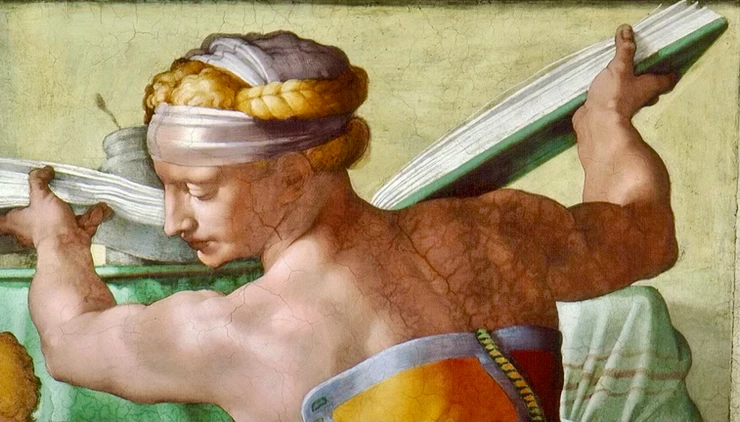
I hope you’ve enjoyed my guide to Italy’s most beautiful chapels. You may enjoy these other Italy travel guides and resources:
- 10 day itinerary for Tuscany
- 10 day itinerary for Italy’s classic cites
- 7 ways to spend 1 week in Italy
- 10 day itinerary from Milan to Rome
- 1 week itinerary from Venice to Milan
- 30 beautiful towns in Italy
- 100+ Italy bucket list experiences
- Tips for visiting Italy
- Historic landmarks in Italy
If you’d like to visit the most beautiful chapels in Italy, pin it for later.

